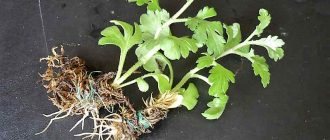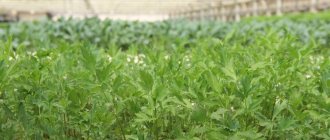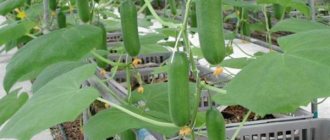You don't have to wait until spring to enjoy fresh, crunchy radishes. In winter it can be grown in a greenhouse. However, it will be possible to reap an excellent harvest only if agricultural techniques are followed. Radishes must be planted correctly and provided with suitable temperature, lighting and humidity.
Landing
Radishes need fertile, loose, well-moistened soil. It is recommended to fertilize it with humus (4 kg per 1 m2), and add peat to the clay soil. Acidic soil must be neutralized, otherwise radishes may get clubroot.
For 1 m2 you will need 2-4 g of seeds. It is better to take large ones, from 2 mm in diameter. Plants grown from small ones turn out to be weaker and die faster. Seeds are planted to a depth of 1 cm at a distance of 3-6 cm from each other, 2 pieces in each hole. Leave 6-10 cm between the rows. You can sow in a continuous line, but then be sure to thin out the seedlings.
Harvesting
It is important not to overexpose radishes in the garden: even good varieties can crack or even lose their valuable taste if left in the ground for a long time. Do not delay harvesting and collect root vegetables when they reach medium size.
To keep radishes longer, it is recommended to shed them in the morning and start harvesting closer to lunch. The collected bunches should be washed in cool water, removing the soil from them. If you will not sell the crop today, then it is better to trim the tops, leaving 5-7 cm of stems: this will extend the shelf life so that you have time to successfully sell the root crops.
The bunches need to be dried, wound with thread, placed in a bag and put in the refrigerator, where they can be stored (provided the tops are cut) for 2.5-3 weeks.
Growing radishes is a fairly successful business that can easily be implemented in a heated greenhouse. To harvest the crops that are in demand in winter and spring, you need to:
- arrange heating in the greenhouse;
- fill the beds with a nutritious soil mixture based on rotted manure or three-year-old compost;
- purchase varieties of early ripening hybrids that are resistant to bolting and cracking;
- provide plantings with 12-hour daylight hours;
- keep the soil in the radish beds constantly moist.
These activities are, of course, quite labor-intensive and require investments, but if there are opportunities to sell the harvest, the money spent will quickly pay for itself, and your favorite activity will bring significant income in winter.
Delicious, slightly spicy, radishes are popular throughout the year. With the right approach, a radish growing business can bring good profits. It is especially profitable to sell vegetables in winter, during a period of limited supply. To get a good harvest, it is necessary to create conditions in the greenhouse that are as close to natural as possible.
Growing radishes in a greenhouse
Greenhouse for growing radishes
Contents of step-by-step instructions:
Temperature
Until the seeds have sprouted, the temperature is maintained at 18-20°. After emergence of seedlings, it is reduced to 5-8° so that the sprouts do not stretch. After a week, the following regime is established:
• in sunny weather – 15-18°,
• on cloudy days – 12-14°,
• at night – 8-10°,
• soil temperature – 12-16°.
Radishes don't like heat. In such conditions, root crops grow flabby, with voids inside. At 24-26° and above they do not form at all. But radishes are quite resistant to cold. Adult plants can tolerate short-term frosts down to -5°, and seedlings - up to -3°.
Greenhouse preparation
The most important thing in growing the right radish is a properly prepared greenhouse. It is clear that it should have a temperature that is comfortable for the root crop, but what else? Radishes need constantly moist soil; it is under these conditions that they turn out tasty and especially juicy, which means you need to organize the correct watering system. If you cannot constantly come and irrigate the beds with a watering can, lay automatic drip irrigation over them.
In addition, radishes need special daylight hours: short, up to 12 hours, but intense. The winter sun is clearly not enough for the root crop, so we hang lamps of the white-red-blue spectrum, which will give the vegetable the required “vitamins”. If you skip this step, the radishes will be stunted and eventually go to waste, and your efforts and expenses will be in vain.
Next, you should consider the heating system. If we were growing radishes for sale in March, it would be enough to simply cover the beds inside the greenhouse with geotextiles, but in winter this measure will not be enough to ensure the required temperature. So how can you heat a greenhouse? There are several ways to do this:
- Biological. The most labor-intensive but economical method. It is based on a special layering of the beds: all the soil is removed, a layer of unripened manure is placed on the bottom (this will release the required heat, heating the greenhouse), then a layer of nutrient soil mixture 20 cm high is formed.
- Electric. For such heating you need to purchase a special heating cable and protective nets. Excess soil is removed from the greenhouse, a mesh is laid out on flat ground, a cable is placed on it, which is again covered with protective material. Afterwards, the formation of the beds begins: a 5 cm layer of sand is scattered on the mesh, and 20 cm of nutritious soil mixture is sprinkled on top.
- Water. This method requires a thorough approach and laying a system of water pipes under the beds. An electric boiler or a homemade stove with a container can heat the water.
You can also use electric radiators installed at different ends of the greenhouse or infrared heaters for heating. To save electricity, you can turn them on as needed, maintaining the required temperature.
The soil
Another important stage in preparing a greenhouse is the creation of a nutritious soil mixture. Ideally, you need to put it in the greenhouse in the fall, mixing ordinary garden soil with manure humus in equal parts; it will be useful to add a couple of buckets of ash here.
Such “seasoned” soil does not require fertilization, although many sources recommend adding superphosphate and potassium nitrate according to the instructions. A week before the planned sowing, the beds need to be fluffed up with a pitchfork, watered and covered with film.
Watering
Until the seedlings emerge, the soil is only sprinkled with water, since with normal watering the seeds may go deep and not germinate. After sprouts appear, water the radishes moderately, but do not allow the soil to dry out. When real leaves appear, water it more often. Usually once every 2-4 days is enough. The soil should be moist to a depth of 15-25 cm.
After watering, it is sometimes recommended to loosen the soil, but this must be done carefully so as not to injure weak shoots. If the planting area is small, this can be done using miniature devices - sticks or cloves.
When radishes form roots, it is very important to maintain the necessary soil moisture. If the soil has been dry for several days, the damage cannot be corrected even with subsequent regular watering. Lack of moisture makes root vegetables rough, bitter, and empty. Due to irregular watering, they may crack. Always moderately moist soil is a necessary condition for growing radishes.
Planting radishes in a polycarbonate greenhouse according to the lunar calendar 2021
As you can see, planting radishes is a very simple operation that does not require special knowledge. But as in any business, there are nuances and subtleties. One of these features that allows you to grow a larger harvest is planting according to the 2021 lunar calendar. It can be treated differently, but those who plant on favorable days experience better results. Try it too.
Let's look at the calendar and determine favorable days for planting:
- February: 20-24
- March: 20-25
- April: 19-24
- May: 18-21
If you pay attention, you will see that favorable days fall on the waning moon. This is the basic rule of the lunar calendar for gardeners and gardeners. Everything that grows underground is planted on the waning moon, and everything that grows above the ground is planted on the waxing moon. Remember this, look at the calendar and choose the most favorable days for you.
Lighting
Proper lighting is fundamentally important. With its deficiency, plants are stretched and root crops are not formed. With severe light starvation, the sprouts may die, having already grown 3-4 true leaves. Thickened crops also lead to slight shading, resulting in small radishes. If there is not enough light, but it is warm, only tops grow without root crops.
Excess light is also harmful, it leads to early bolting. With 14 hours of daylight or more, radishes will definitely begin to bloom to the detriment of the harvest. The optimal duration is 8-9 hours per day, the minimum intensity is 1500-2000 lux. The brighter the lighting, the faster the root crops will form.
Harvesting and storage
You can enjoy radishes after the fruits reach their characteristic size and color. Botanists recommend not delaying collection. Otherwise, the vegetable will lose its nutritional properties. On the day when it is planned to harvest, the last watering is carried out around 8-9 am. The harvest takes place around 14-15 hours. The procedure is as follows:
- carefully remove the vegetable from the ground;
- cut off the tops (they are then used to mulch the soil);
- carefully remove the leaves - make sure not to harm the fruit;
- wash the fruits in a large volume of cold water;
- wipe the radishes with a paper towel;
- Place the fruits in a plastic bag.
The harvested vegetable is stored in the refrigerator for 4 weeks.
Diseases
Radishes can suffer from downy mildew, fomosis, black leg, white and gray rot, alternaria, and mucous bacteriosis. As a preventative measure, it makes sense to warm the seeds for 20 minutes at a temperature of 48-49° before planting, and then cool them in cold water for 2-3 minutes. Before sowing, the soil can be treated with potassium permanganate (1.5 g per 5 liters of water) or copper sulfate (1-2 tbsp per 10 liters).
It is necessary to avoid thickening the plantings, and also, if necessary, ventilate the greenhouse to get rid of dampness. Recommended relative humidity is 65-70%. At 80% and above, the risk of disease increases.
Growing radishes as a business
You can harvest radishes in a greenhouse all year round, so many gardeners grow this crop for sale. It is noteworthy that such a business is easy to start from scratch, since products grown on your own plot are not taxed.
So, you should start with small sales, and later, if this business is profitable, you can register as an individual entrepreneur. This will make it possible not only to sell root crops independently, but also to supply products to stores and the market.
When registering a business, you should indicate “agricultural production” as an activity, since agricultural producers receive support from the state.
Beginning entrepreneurs should consider several recommendations:
- in order to continuously obtain root crops for sale, it is worth planting seeds every 1.5-2 weeks;
- The emphasis in your business should be on quality - choose varieties for cultivation and subsequent sale that bear tasty fruits;
- Mainly grow classic varieties, but you can gradually add exotic varieties;
- increase production in winter and summer, when radishes are in great demand.
Compared to other crops, radishes can be easily grown in a greenhouse, but the plant may shoot prematurely and produce woody or flabby roots. To prevent such consequences, do not neglect the rules of radish agricultural technology and provide the plant with optimal growing conditions.
0
0
Copy link
Harvest
The growing season of greenhouse and ground radishes is somewhat different: the greenhouse vegetable ripens later. On average, you can get a harvest 2 months after sowing. The process is also influenced by the variety of root crop, lighting level and temperature conditions. Gardeners do not recommend delaying harvesting: radishes should be harvested when they reach medium size, become juicy and acquire the color characteristic of the variety.
Radish harvest
Tip: Water the plants a few hours before harvesting. The optimal combination: watering in the morning and cleaning in the afternoon.
The harvested crop needs to be processed. If you do not plan to sell the vegetable immediately, along with the tops, trim off the leaves. Then rinse the radishes with cold water and lightly dry. Root vegetables can be stored in the refrigerator for 3-4 weeks.
The collected radishes need to be washed, dried and the tops cut off.
There is a technique that allows you to store vegetables for a long time. Radishes are placed in wooden boxes, the bottom of which is covered with polyethylene. Vegetables are sprinkled with a mixture of peat and sand. The sand-peat mixture protects root crops from rotting.
Is it worth the risk of planting radishes before winter?
This issue must be resolved by each gardener personally. But it is worth paying attention to several clear advantages of sowing vegetables in winter. Let's highlight them: it will allow you to get a harvest 2-3 weeks earlier than in the spring, and if you cover the seedlings with film, you can speed up ripening by another 7-12 days. The result is almost a month!
- The seeds that spent the whole winter in the ground were well hardened, went through natural selection (the weak ones died), which means the plants will be stronger and healthier;
- with winter sowing, you can forget about worries about a dry spring;
- as soon as the snow begins to melt, the seeds swell and begin to grow together, using 100% of spring moisture, at a time when spring sowing is still being planned. resistance to frost, diseases and pests;
- young sprouts of winter-sown vegetables and herbs tolerate frosts without loss (from personal experience I can say that a temperature of -3°C will not cause them the slightest harm), and early shoots are not attacked by carrot flies and cruciferous flea beetles, which are still sleeping at this time .











